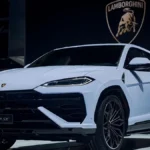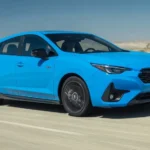Polestar, once known for racing, is now a key player in electric vehicles (EVs). It started as a partnership between Volvo Cars and Geely Holding. Now, it’s an independent brand focused on luxury EVs. Founded in 2017, Polestar aims to be in 30 markets by 2022, up from 10 in 2020.
Polestar is making waves in the EV world. In 2021, it hit its goal of delivering 29,000 vehicles worldwide. Its orders are at an all-time high, showing over 75,000 vehicles a year. This growth shows Polestar’s strong position in electric mobility.
Key Takeaways
- Polestar has evolved from a racing brand to a standalone electric vehicle manufacturer, founded in 2017.
- The company has rapidly expanded its global presence, aiming to be in 30 markets by the end of 2022.
- Polestar achieved its 2021 target of delivering 29,000 vehicles and has a record-high order intake.
- The company’s commitment to innovation and sustainable luxury EVs positions it as a leader in the EV revolution.
- Polestar’s success highlights the brand’s transformation and its growing influence in the electric vehicle industry.
The Evolution of Polestar: From Racing to Electric Innovation
Polestar’s journey is truly remarkable. It started as a Swedish racing team and now leads in electric vehicles. Its partnership with Volvo has been key. Together, they’ve pushed the limits of car technology and electric performance.
From Volvo Partnership to Independent Brand
In 1996, Polestar was Flash Engineering, a racing team. By 2009, it became Volvo’s performance partner. In 2015, Volvo fully bought Polestar. This change made Polestar an independent brand focused on electric luxury cars.
Early Achievements in Electric Mobility
The Polestar 1, a plug-in hybrid coupe, was introduced in 2017. It showed Polestar’s dedication to performance and green tech. This car was a big step for Polestar in the electric car market.
The Polestar 2, launched in 2019, is an all-electric luxury SUV. It has a 78 kWh battery and goes 245 miles on a charge. It competes with the Tesla Model 3, known for its Scandinavian design and tech.
Market Entry Strategy
Polestar quickly expanded globally. It started in 10 markets in 2020 and reached 25 by mid-2022. This fast growth helped Polestar meet the rising demand for electric cars, making it a top player in the car world.
| Metric | Value |
|---|---|
| Polestar’s Founding Year | 1996 |
| Volvo Acquisition of Polestar | 2015 |
| Polestar 1 Release Year | 2017 |
| Polestar 2 Release Year | 2019 |
| Markets Served in 2020 | 10 |
| Markets Served by Mid-2022 | 25 |
“Polestar’s journey from a racing team to a leading player in the electric vehicle revolution is a testament to the brand’s commitment to innovation and performance.”
Global Expansion and Market Presence
Polestar is a leading electric vehicle brand that has quickly grown worldwide. By the first half of 2022, it had launched in 25 markets. New places like the UAE, Kuwait, Hong Kong, Ireland, Spain, and Portugal were added.
The company plans to enter Israel and Italy by 2023. It aims to be in at least 30 markets by then. As of 2022, over 55,000 Polestar cars were on the road globally. This shows the brand’s growing popularity worldwide.
| Key Market Expansion Milestones | Impact |
|---|---|
| France becomes the largest volume EV market in the EU after Germany | Significant growth opportunity for Polestar |
| Sweden and Norway transition to non-genuine agency sales model | Polestar well-positioned to capitalize on this shift |
| Appointment of new regional leaders in North America, UK, and Norway | Strengthens Polestar’s local market expertise and execution |
Polestar’s success comes from its focus on global markets and emission-free driving. It continues to grow and lead in the electric car industry.
Polestar’s Commitment to Sustainable Luxury
Polestar is a premium electric car brand that has been perfecting electric mobility for ten years. Its focus on sustainable luxury shows in every detail of its cars. The brand’s Scandinavian design is not just beautiful but also eco-friendly.
Scandinavian Design Philosophy
Polestar’s design is all about clean lines and simplicity. It’s a Scandinavian style that values sustainability. The brand uses recycled and renewable materials and aims to reduce energy use and emissions.
Environmental Impact Solutions
Polestar goes beyond just designing green cars. It has big goals for reducing its carbon footprint. By 2030, it wants to make a car that’s climate-neutral and cut emissions in half. It also aims to be carbon-neutral across its whole operation by 2040.
Material Innovation and Recycling
Polestar is all about using sustainable materials and recycling. The Polestar 4 uses recycled PET fabrics and bio-attributed MicroTech for seats and dashboards. The Polestar O2 concept car shows the brand’s commitment to circularity, with recycled polyester in its interior.
| Metric | Value |
|---|---|
| Cradle-to-Gate Carbon Footprint Reduction (Polestar 3) | Reduced compared to earlier models |
| Battery Range (Polestar 3) | Exceeds many competitors in its class |
| Absolute Emissions Increase (2022 vs 2021) | 67% due to company growth and increased sales |
| Climate Neutrality Target | 2040 |
Polestar leads in Scandinavian design, environmental impact solutions, and material innovation and recycling. As it grows its range of premium electric cars, it stays true to its mission of a greener future for cars.
The Revolutionary Polestar 3: Entering the SUV Market
Polestar, a brand owned by Volvo and Geely, is entering the SUV market with the Polestar 3. This all-electric SUV will hit the market in 2023. It promises to change the game with its design, tech, and performance.
The Polestar 3 comes with a dual-motor setup, giving it 402 horsepower and 660 lb-ft of torque. It has a 78 kWh battery pack for up to 300 miles on a single charge. The Performance Pack adds 22-inch wheels and Pirelli tires for better performance.
The interior features a 15-inch touchscreen and a 12.3-inch digital cluster. It uses Google’s in-car system for easy access to Google services. This makes driving more connected.
| Key Specifications | Value |
|---|---|
| Battery Capacity | 78 kWh |
| Estimated Range | 300 miles (EPA) |
| Power Output | 402 hp, 660 lb-ft of torque |
| Acceleration (0-60 mph) | 4.6 seconds |
| MSRP | $83,900 (well-optioned models) |
The Polestar 3 shows Polestar’s commitment to sustainability. It has vegan leather and a focus on minimalism. Its exterior features a full-width LED taillight bar for a modern look.
The Polestar 3 is a big step for Polestar, expanding its lineup in the SUV market. With its tech, performance, and green focus, it’s set to change the electric SUV scene.
Polestar 4: Redefining the SUV Coupe Segment
Polestar is introducing the Polestar 4 in 2023. This SUV coupe is set to change the game in performance EVs. It combines sleek design with top-notch performance.
Design and Performance Features
The Polestar 4 has a unique look, with a sloping roof and a new rear end. It’s built on the Sustainable Experience Architecture (SEA) platform. It’s 190 inches long, 84 inches wide, and 60.7 inches tall, with a 2999 mm wheelbase.
It comes with a big 94 kWh battery pack for up to 350 miles on a single charge. The dual-motor version goes from 0 to 60 mph in 3.8 seconds. The single-motor version can go up to 373 miles and hits 62 mph in 7.4 seconds.
Technology Integration
The Polestar 4 is packed with the latest tech and safety features. It supports up to 200 kW DC and 22 kW AC charging. It also has bi-directional charging and an eight-year warranty on electrical parts.
Prices start at around $60,000 for the base model and $80,000 for the dual-motor version. It’s a strong contender against the Tesla Model Y and Porsche Macan EV, with its mix of style, performance, and tech.
“The Polestar 4 is a game-changer in the SUV coupe segment, delivering uncompromising performance and cutting-edge technology in a sleek, sustainable package.”
The Ambitious Polestar 5: GT Performance Redefined

Polestar, a Swedish electric vehicle brand, is about to change the GT performance game with the Polestar 5. This car is set to launch in 2024. It’s a fully electric 4-door GT that aims to break new ground in power and efficiency.
The Polestar 5 has a special, bonded aluminum platform. This makes it very light and strong. It’s designed to improve the car’s efficiency and performance, giving drivers an unmatched experience.
The Polestar 5 will have a powerful new engine. It combines a front and rear electric motor for 650 kW (884 hp) and 900 Nm of torque. Thanks to its 800-Volt architecture, it will charge and accelerate faster than the Porsche Taycan Turbo S.
| Specification | Polestar 5 | Porsche Taycan Turbo S |
|---|---|---|
| Horsepower | 884 hp | 761 hp |
| Torque | 900 Nm | 1,050 Nm |
| 0-62 mph | under 2.8 seconds | 2.8 seconds |
| Battery Capacity | 103 kWh | 93.4 kWh |
| Estimated Range | 300 miles | 206-246 miles |
| Starting Price | ~$100,000 | $86,700 |
The Polestar 5 is ready to take on the top GT performance cars in the electric market. With its groundbreaking features, it’s set to be a major player in the luxury GT segment.
Breakthrough Battery Technology and StoreDot Partnership
Polestar, a leading electric vehicle brand, has teamed up with StoreDot. They are innovating in extreme fast charging (XFC). This partnership aims to solve a big problem for electric cars – battery technology and fast charging.
Extreme Fast Charging Innovation
StoreDot’s battery tech can charge a 77kWh battery pack to 80% in under 10 minutes. The battery pack’s charge rate stayed above 310kW, hitting over 370kW at times. This shows the tech is ready for the market.
StoreDot wants to charge an EV to 100 miles in just 4 minutes by 2026. They aim to cut this time to 3 minutes by 2028. This could make people less worried about charging their EVs, helping more people choose electric cars.
Future Charging Solutions
- StoreDot’s silicon-based anode tech boosts energy density and charging speed for future batteries.
- Polestar is working on adding StoreDot’s XFC tech to its battery module prototype. They aim for 10-80% charging in 10 minutes.
- This partnership means EVs can use common charging spots for fast charging. This makes owning an EV more practical and easy.
“The electric vehicle (EV) battery technology demonstrated by StoreDot and Polestar can charge a 77kWh battery pack from 10 percent to 80 percent in under 10 minutes.”
| Metric | Value |
|---|---|
| Consistent Charge Rate | Over 310kW |
| Peak Charge Rate | Over 370kW |
| Battery Pack Capacity | 77kWh |
| Charging Time (10% to 80%) | Under 10 minutes |
The partnership between Polestar and StoreDot is a big step for battery technology and fast charging. It’s moving us towards a greener and more convenient electric car future.
Advanced Driver Assistance Systems and Safety Features
Safety is a top priority at Polestar. The company is adding cutting-edge Advanced Driver Assistance Systems (ADAS) to its cars. This ensures top safety for everyone inside.
The Polestar 2 uses many sensors to watch its surroundings. It has three radar units, five cameras, and twelve ultrasonic sensors. These help prevent accidents.
The car’s computer sorts out what it sees and acts fast. It can steer the car back on track if it drifts. It also keeps the car in its lane and warns of oncoming traffic when reversing.
Polestar goes beyond just ADAS. The Polestar 2 has features like Adaptive Cruise Control and a system to keep drivers alert. It also has a system to help stop the car in case of a crash.
The car’s battery is safe in crashes, thanks to a strong frame. Its safety cage is made of ultra-strong steel. This earns it a 5-star Euro NCAP safety rating.
Polestar keeps improving its safety features. The Polestar 3 will have LiDAR technology and a new computer system. This will make it even safer.
Polestar is all about safety in its cars. It uses advanced sensors and smart systems to avoid accidents. The brand is at the forefront of car safety, making driving safer for everyone.
Polestar O2: Vision of Electric Performance
Polestar, a Swedish electric vehicle maker, has introduced the Polestar O2. This car is a hard-top convertible that shows off electric power. It also has a special drone that can fly while the car moves, capturing videos at speeds up to 90 km/h.
The Polestar O2 shows Polestar’s focus on being green. It uses recycled polyester for parts and has cool design ideas. Even though it’s not confirmed for production, it shows what Polestar can do in electric cars.
Innovative Drone Technology
The Polestar O2 has a cool drone feature. This drone lets drivers record their drives in real-time. It has three modes: swooping arcs, atmospheric feel, and close-up shots of the people inside.
Sustainable Materials and Design
Polestar cares about the planet, and it shows in the O2. The car uses a special aluminum platform for better handling. Its interior parts are made from materials that can be recycled, showing Polestar’s green goals.
The O2 also works with PANGAIA to find new ways to be sustainable. This partnership aims to make the future better for our planet.
“The Polestar O2 concept showcases our vision for electric performance and sustainability, blending cutting-edge technology with a commitment to environmental responsibility,” said Thomas Ingenlath, CEO of Polestar.
Even if the Polestar O2 won’t be made, it shows Polestar’s creativity. It shows their drive for electric cars and caring for the environment in the car world.
Vehicle-to-Grid Technology and Energy Integration
Polestar is leading the way in Vehicle-to-Grid (V2G) technology. This tech lets electric vehicles (EVs) not just take energy but also give back. It’s a big step towards making EVs part of the energy system, helping owners save money or even sell energy.
At Polestar Day, they showed off how Polestar 3 vehicles could power cities using a mini 3D model of Los Angeles. A test in Gothenburg, Sweden, showed that V2G cars could meet up to 20% of the city’s energy needs.
Polestar is starting a new pilot in Sweden to test V2G technology. They’re working with the Swedish Energy Agency and other companies. The goal is to make EVs a valuable resource for the energy market.
By using V2G, Polestar wants to help switch to green energy and lower EV costs. They’re launching a big project in Gothenburg with a fleet of Polestar 3 cars. They’re working with Easee, Svenska Kraftnät, and others.
This project aims to make V2G technology work on a big scale. It will use bi-directional charging to help the energy grid and provide backup power. They’ll use a special charger from Easee for this.
| Key Insights | Potential Impact |
|---|---|
| Only 30% of EV owners globally would need to opt into V2G programs to meet energy storage demand by 2030. | California could power every household for three days using the energy stored in its estimated 14 million EVs by 2035. |
| V2G-connected vehicles may contribute up to 20% of the demand for flexibility services in Gothenburg, Sweden. | Polestar’s V2G pilot project in Gothenburg aims to establish EVs as a flexible energy resource in the market. |
Polestar is all in on V2G technology and energy integration. They see a future where EVs are key to a sustainable energy system. By using their vehicles, Polestar wants to help customers, support the grid, and push for green energy.
Manufacturing Excellence and Production Capacity
Polestar, a top electric vehicle (EV) brand, is growing fast to keep up with demand. It plans to make over 160,000 vehicles a year by 2025. This includes the Polestar 3 and Polestar 4 models.
This big plan shows Polestar’s commitment to growing and attracting more customers. The company is working with partners and using new ways to make cars. This ensures quality and efficiency in its production.
| Key Manufacturing Statistics | Data |
|---|---|
| U.S. manufacturing executives agreeing that the frequency of disruptive events has greatly increased in the last 10 years | 90% |
| Main components of a production plan |
|
| Benefits of automation in resource management for production planning | Effective material, capacity, equipment, and manpower utilization |
| Polestar 3 production start and first customer deliveries |
|
| Additional Polestar 3 manufacturing in the US |
|
| Polestar 3 safety features |
|
| Polestar 3 battery and performance |
|
| Polestar 3 advanced sensors |
|
Polestar is set to lead in EV production and manufacturing. It’s ready to meet the demand for green and powerful electric cars. This will solidify its place in the EV production and manufacturing world.
Digital Innovation and User Experience

Polestar is all about digital innovation. It shows in how it uses Google services in its cars. For example, the Polestar 4 has Android Automotive OS. This lets drivers use Google Maps for better routes and stay updated on charging.
The Polestar 4 also has a digital rearview mirror. It gives a 120-degree view, making driving safer and clearer. These tech features show Polestar’s commitment to making driving easy and fun for its customers.
Google Integration
Polestar teamed up with Google to make its cars super user-friendly. With Android Automotive OS, drivers get Google Maps for easy navigation. They also get updates on charging in real-time, making driving stress-free.
Connected Services
Polestar doesn’t stop at just car tech. It also offers connected services to make driving better. These services use the latest tech to give drivers a personalized experience. It’s all about making driving fit your needs and likes.
“Polestar’s commitment to digital innovation is evident in the seamless integration of Google services within its vehicles, ensuring a truly connected and technologically advanced driving experience.”
Polestar’s focus on digital innovation and user experience has earned it many awards. It won the W3 Gold Award for User Experience and was a Fast Company Honoree in Retail and User Experience. These wins show Polestar’s dedication to top-notch tech and happy customers.
By using Google services and creating connected features, Polestar leads in digital innovation and user experience in electric cars. These advancements make driving better and set new standards for the industry.
Strategic Partnerships and Collaborations
Polestar has teamed up with industry leaders and startups to boost innovation and green tech in cars. They work together on better batteries, self-driving tech, and eco-friendly materials. This teamwork helps move the auto world forward.
They’ve partnered with StoreDot for super-fast charging batteries. This partnership aims to make charging electric cars much quicker. Polestar also works with Luminar and Mobileye to add top-notch safety features to their cars.
Polestar also partners with companies focused on green materials and recycling. At events like Polestar Day, they show off their work. This shows their commitment to making electric cars better and caring for the planet.







